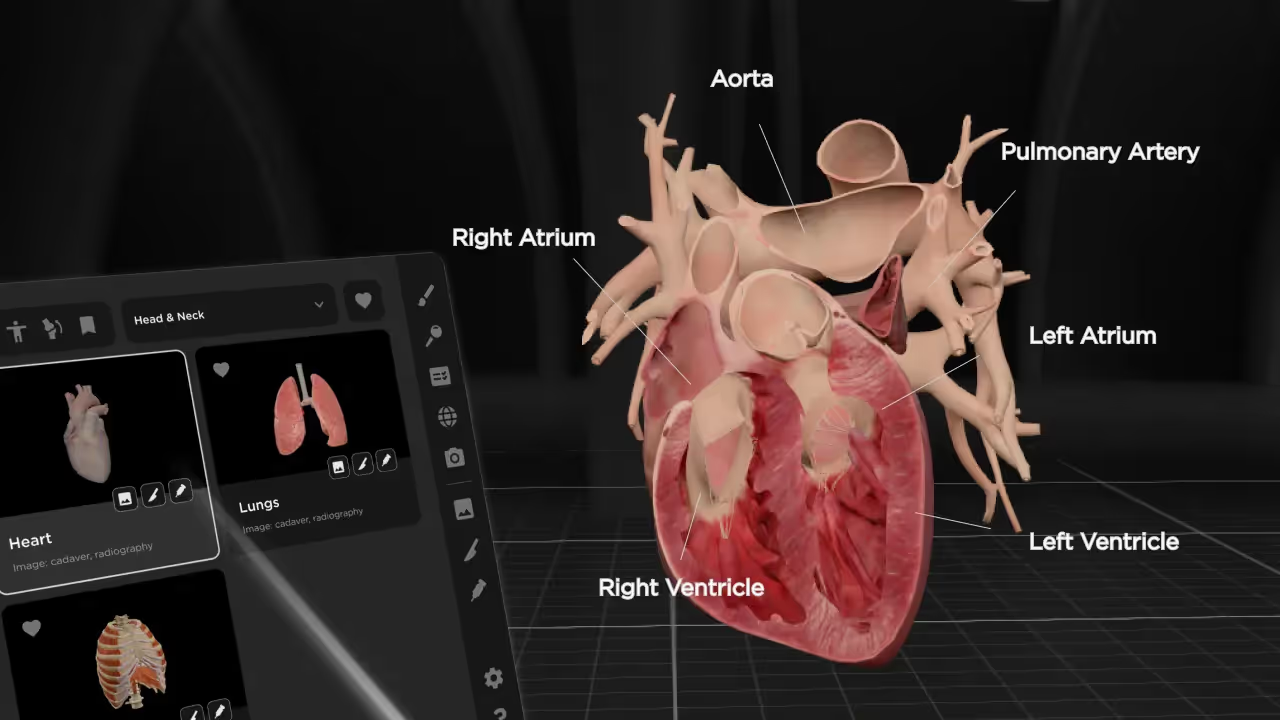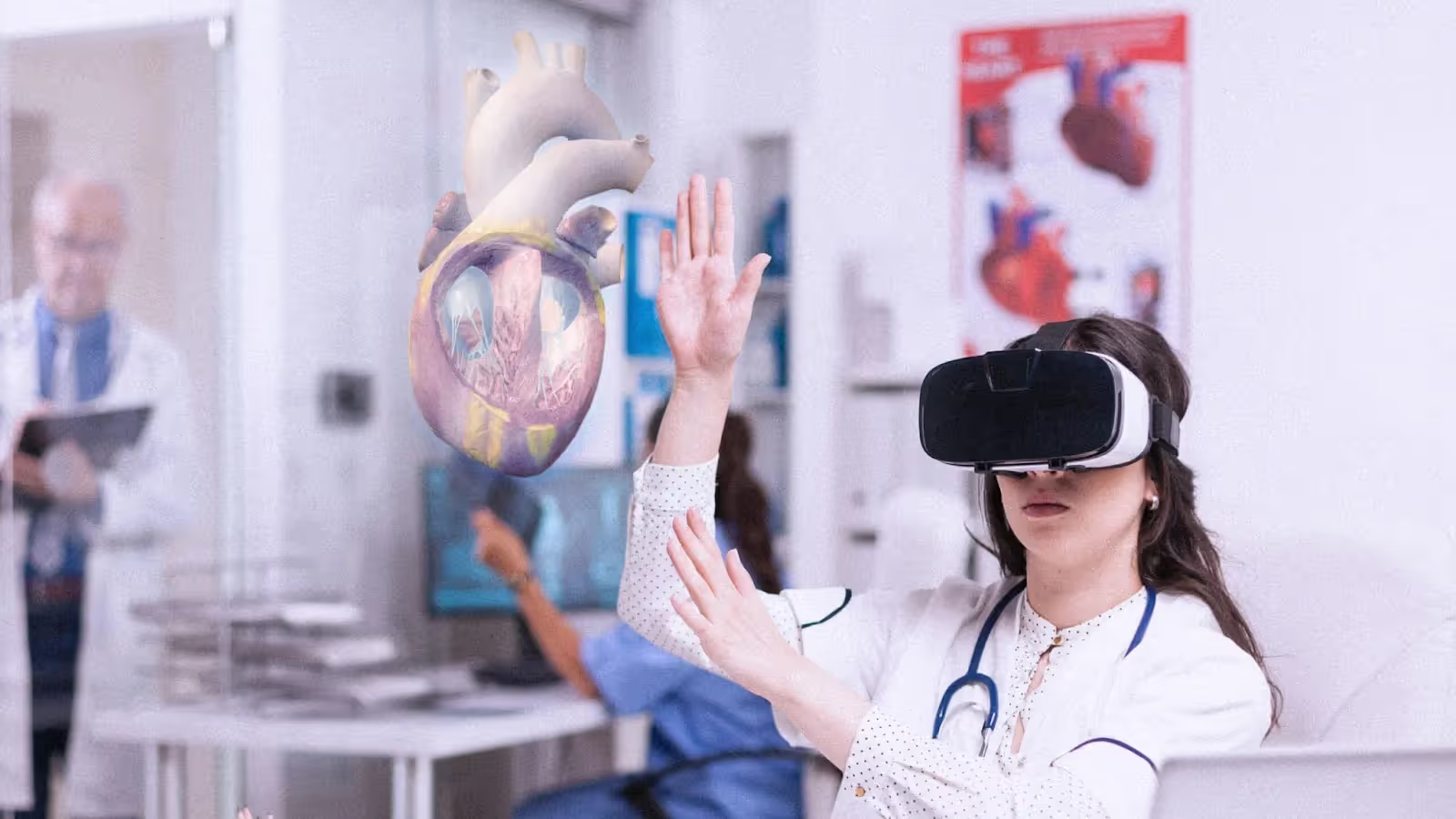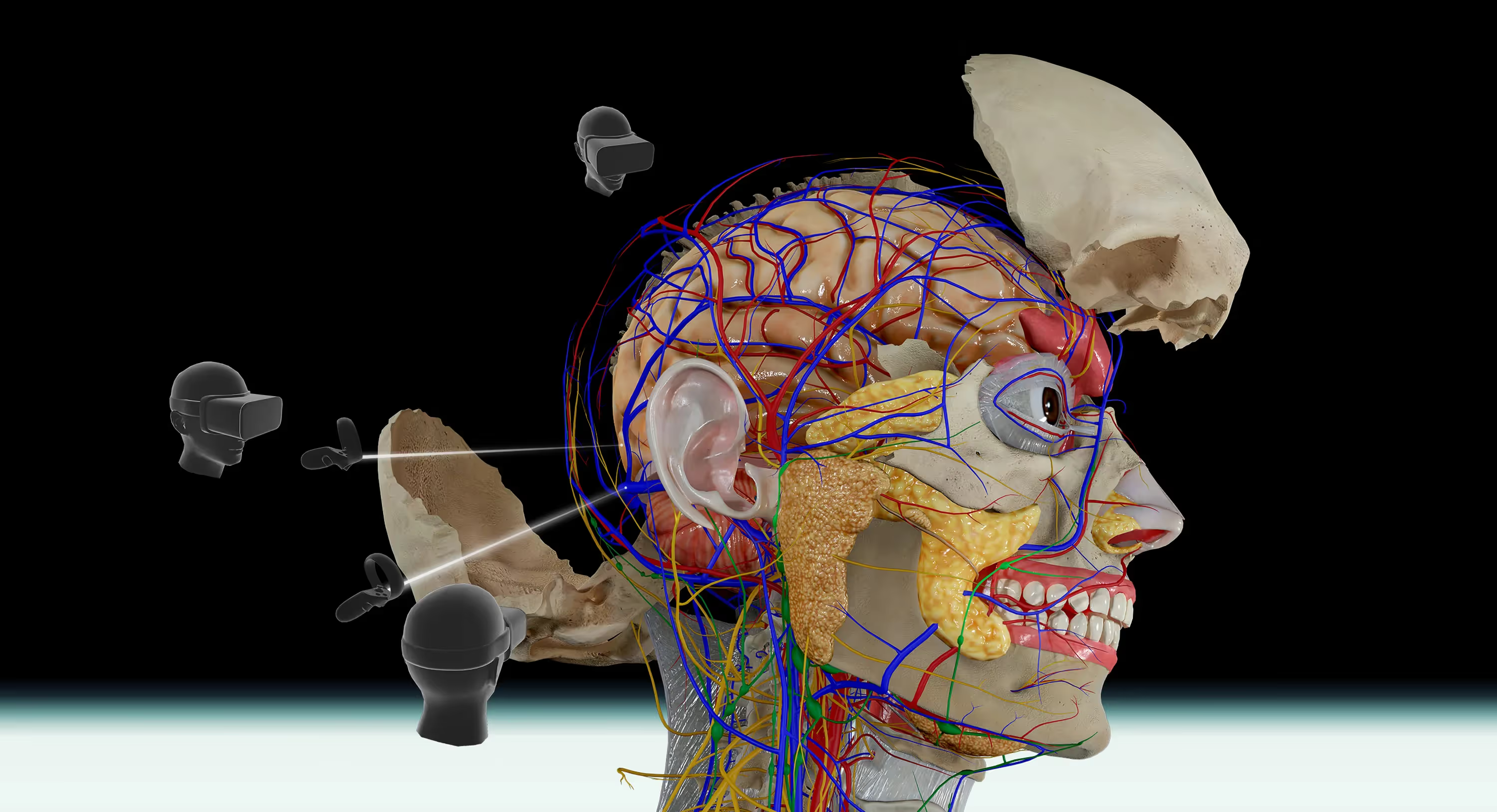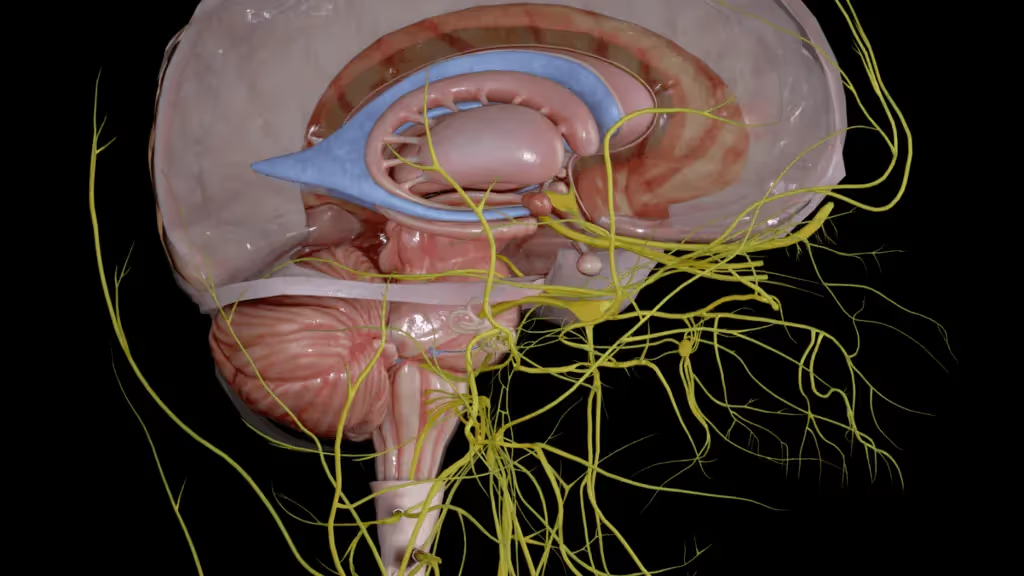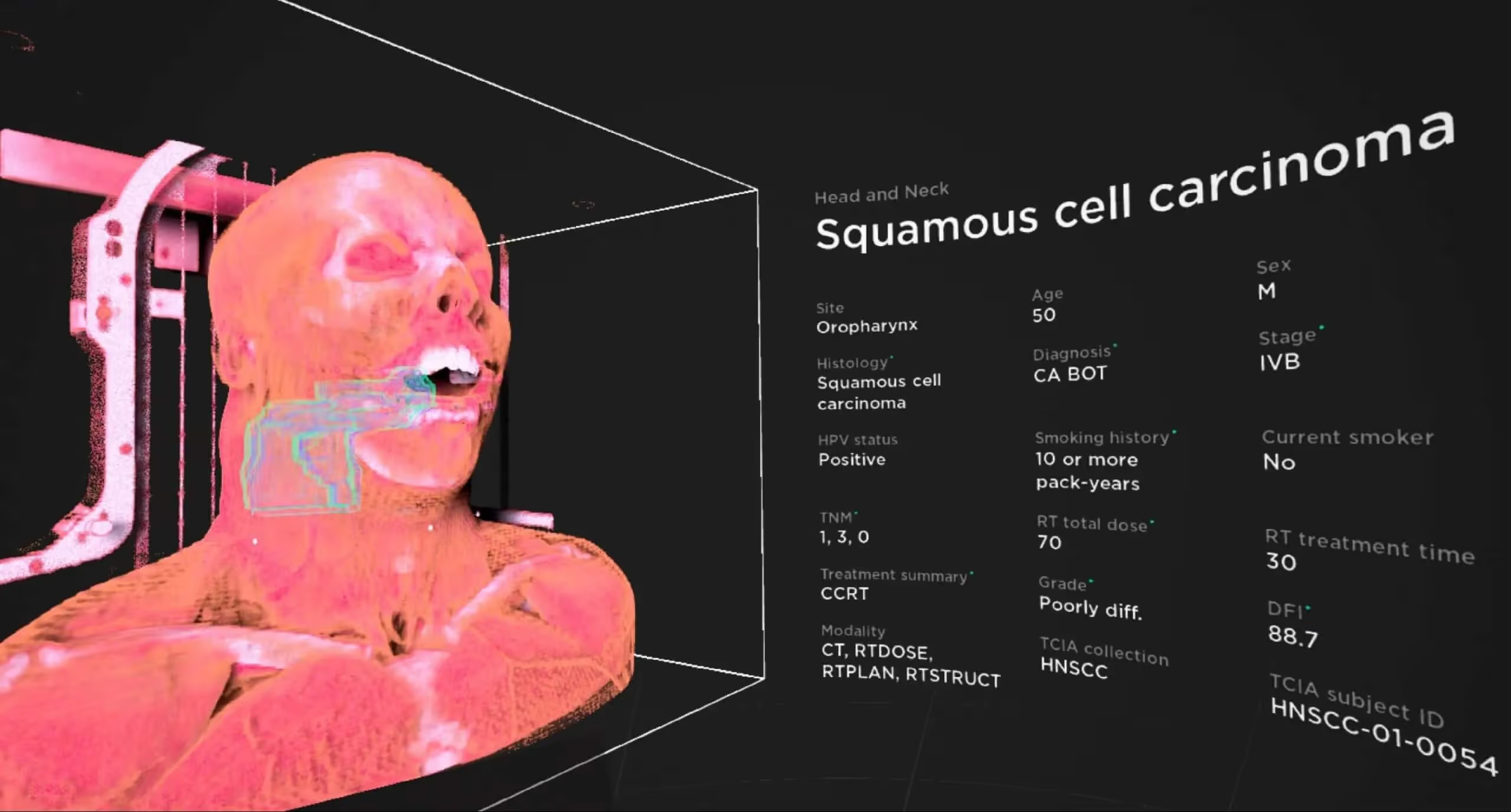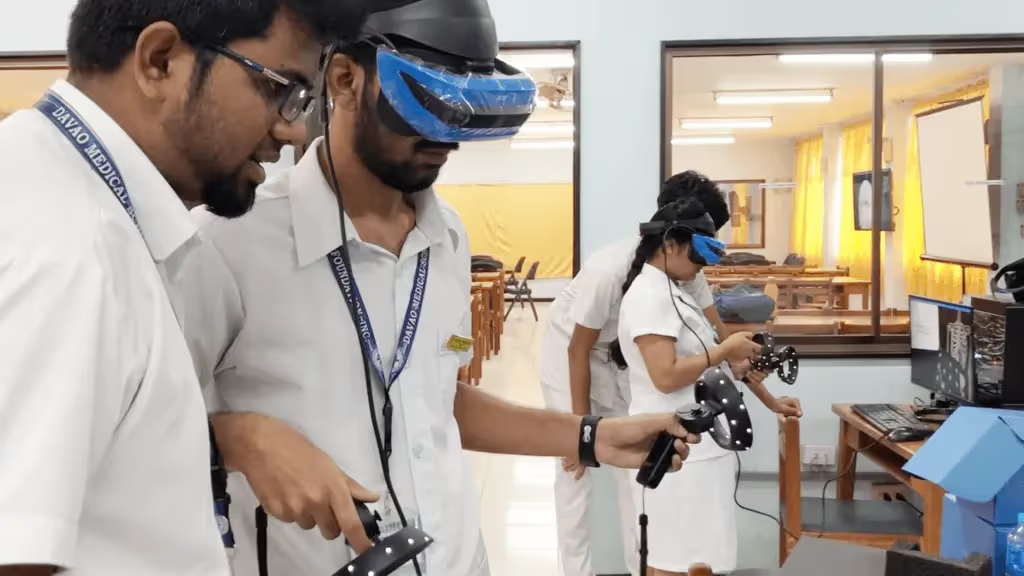Overview
This condition is now more commonly referred to as undifferentiated pleomorphic sarcoma in current medical literature.
This case study is presented as an educational tool, illustrating how medical students can use VR anatomy applications like MAI’s BodyMap for immersive exploration of tumor locations, spatial relationships, and procedural planning.
Case Snapshot
Name: Bernie Saxophone
Gender: M
Age: 49
Cancer: Sarcoma
Type: STS
Histology: Malignant Fibrous Histiocytoma (MFH, also called Undifferentiated Pleomorphic Sarcoma, UPS)
Grade: High
Site of primary STS: Right thigh
Treatment: Surgery + radiotherapy + chemotherapy
Outcome: Metastasis to lung
Patient Introduction
Bernie, a 49-year-old man, experienced a dull aching pain and swelling in his right thigh after bumping his leg into a kitchen table. He initially treated it as a muscle strain with ice, but the mass persisted and enlarged over five weeks. At his wife's urging, he visited a doctor.
After five weeks without improvement and noticeable enlargement of the mass, Bernie decided to seek medical help, realizing it was not a simple bruise or strain.
Clinical Assessment
Imaging Tests
Physician: When did the pain start? : Bernie: About five weeks ago, but it worsened recently.
Physician: Have you noticed any changes in the lump’s size? : Bernie: It seems to be growing quickly.
The physician asked Bernie when the pain started. Bernie said the pain began about five weeks ago after bumping into the kitchen table.
The physician asked when Bernie first noticed the mass. Bernie first noticed it while climbing stairs, a few days after the injury.
The physician asked if the mass had increased in size. Bernie answered that it seemed larger than before.
The physician asked if the pain was getting worse. Bernie said yes, but thought it was part of the healing process and was not concerned.
The physician asked about medications. Bernie said he occasionally took a pain reliever and had iced the area, following advice he read online.
Based on Bernie’s answers and his history, the physician ordered imaging tests. These included X-ray, magnetic resonance (MR), computed tomography (CT), and positron emission tomography (PET) scans to help visualize the right thigh. The physician also arranged a biopsy to extract tissue from the enlarged area. The pathology report showed high grade malignant fibrous histiocytoma, now called undifferentiated pleomorphic sarcoma, in the right thigh. The physician concluded that the mass in Bernie’s right thigh was not caused by injury. Instead, it was soft tissue sarcoma.
The pathology report returned with a histology finding of high grade malignant fibrous histiocytoma, now referred to as undifferentiated pleomorphic sarcoma, on the right thigh. Taking into account all information collected, the physician concluded that the mass in Bernie’s right thigh was not swollen due to injury, but soft tissue sarcoma.
It is not uncommon for patients with this particular type of soft tissue sarcoma, particularly malignant fibrous histiocytoma (MFH), to assume it stems from a minor injury. However, clinical consensus indicates that the trauma merely drew attention to an existing mass, as supported by the citation in the assessment section.
Grade:
The tumor grade describes a tumor based on how its cells appear under a microscope and gives an indication of the tumor’s aggressiveness, i.e., how quickly the tumor is likely to grow and spread. The grade can help to guide practitioners in making treatment decisions.
High grade tumors tend to be more aggressive and thus have higher tendency to recur and spread
Low grade tumors tend to be less aggressive and thus have lower tendency to recur and spread
Soft Tissue Sarcoma
Soft tissue sarcoma is a group of cancers that forms in soft tissues of the body, such as muscle, fat, nerves, blood vessels, lymph vessels, fibrous tissues, tendons and the lining of joints (NCCN, 2023)[PubMed]. These sarcomas which are rare and constitute less than 1% of all cancer cases can begin in any part of the body, with the most common primary sites including the arms or legs (60%), torso or abdomen (30%), and head and neck (10%) (Cancer.Net, 2023)[Source]. For metastatic soft tissue sarcoma, the most common site of metastasis is the lungs (ACS, 2023)[ACS]. There are more than 50 histologic types of soft tissue sarcomas, with the more common types including malignant fibrous histiocytoma (more recently called "undifferentiated pleomorphic sarcoma"), liposarcoma, and leiomyosarcoma (Radiopaedia, 2023)[Radiopaedia]. While the most common treatment involves surgical removal, depending on the size, type, location and aggressiveness of the tumor, radiation and chemotherapy may also be recommended.
What is Malignant Fibrous Histiocytoma?
Malignant fibrous histiocytoma, also referred to as undifferentiated pleomorphic sarcoma, is an aggressive tumor considered in many studies as the most common type of soft tissue sarcoma, accounting for 25-40% of all adult soft tissue sarcoma cases6 , though some more current studies rank it as the fourth most common soft tissue sarcoma7.
Following the site distribution trend found for soft tissue sarcoma in general, common sites of involvement for malignant fibrous histiocytoma, particularly of localization on the body regions is as follows: greater than 70% of cases located in the extremities (50% of cases in lower extremities and 25% in upper extremities), 15% of cases in the retroperitoneum, and 3-10% of cases in the head and neck region.8 Some patients mistakenly attribute the lump to trauma in the affected area, such as an injury from bumping into the corner of a table.9
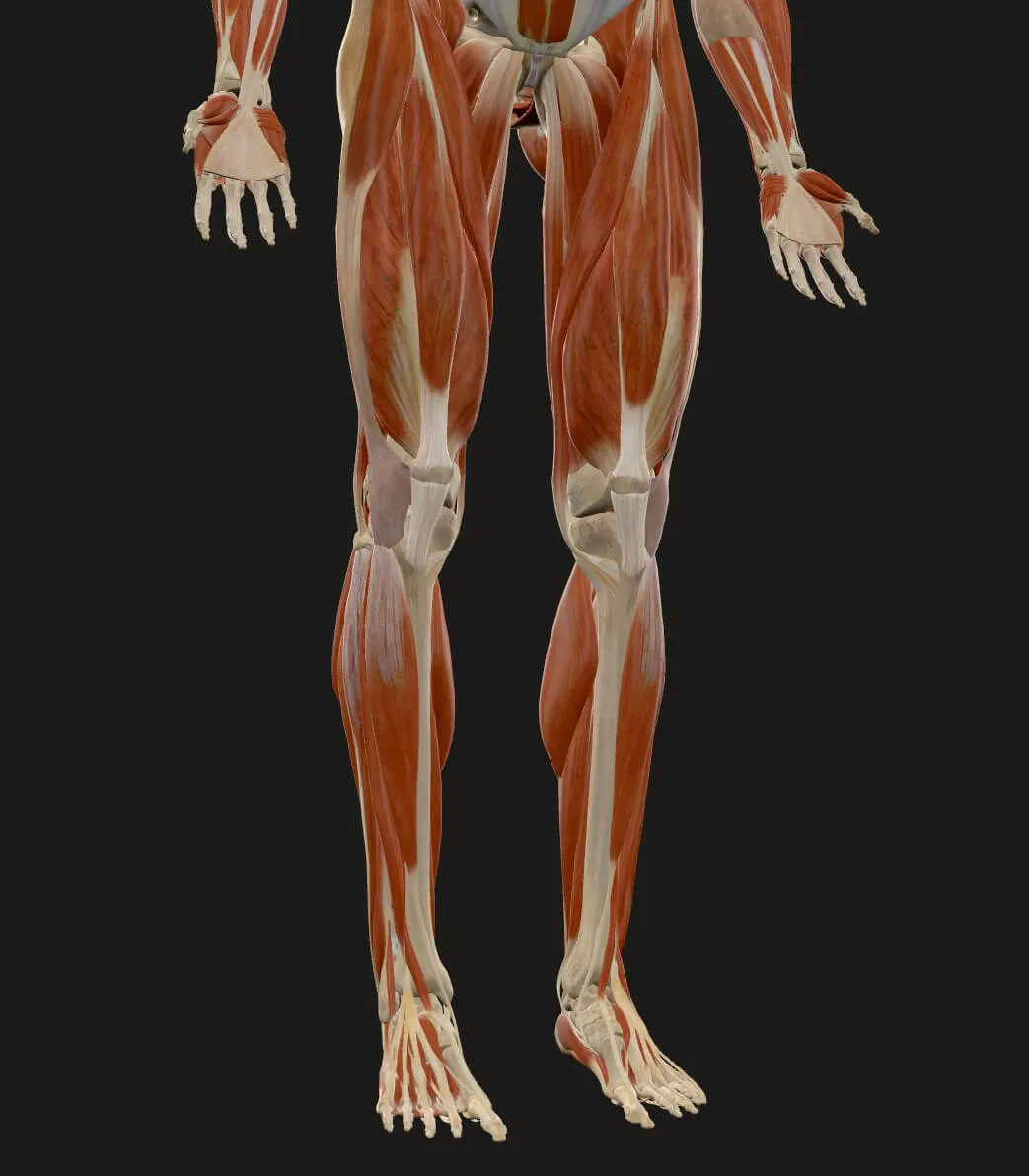
The image of the legs (with emphasis on the right thigh) is taken from the Bodymap VR application.
Individuals with malignant fibrous histiocytoma often complain of a mass or lump, such as a lump on the thigh, that occurred over a short period of time (usually over the course of weeks to months). The mass is also usually found to have enlarged over time. Some patients mistake the lump to be caused by some sort of trauma to the affected area, such as an injury caused by “running into the corner of a table.”9
Bernie has many characteristics consistent with the profile of an individual with soft tissue sarcoma of the malignant fibrous histiocytoma histological type: he is male, Caucasian, middle-aged, and presents with a tumor in the lower extremity. His clinical presentation of a mass in the affected area being rapidly enlarging also resembles that of an individual with malignant fibrous histiocytoma. More details on these characteristics:
Male: there is a slight male predilection for malignant fibrous histiocytoma with a male-to-female ratio of 1.2:110
Caucasian: malignant fibrous histiocytoma is more common in the Caucasian race11
Age: some reports state that malignant fibrous histiocytoma tends to arise most frequently during the sixth and seventh decades of life12 while others suggest this average range is younger at 50 to 70 years of age13. There is also literature suggesting that the range falls between 32 to 80 with a mean age of 59 at diagnosis14.
Extremities: over 70% of malignant fibrous histiocytoma cases are located in the extremities, with 50% in the lower extremities15
Presentation:
Malignant fibrous histiocytoma presents as a rapidly enlarging mass, with reports of dull aching pain or tenderness from 30% of patients. Some patients complain of trauma to the affected area, hematoma, or muscle strain, but in actuality, trauma does not cause malignant fibrous histiocytoma.1 Systemic symptoms are not typically expected.
Treatment Planning
After evaluating Bernie’s symptoms and results from diagnostic tests and scans, Bernie’s multidisciplinary healthcare team formulated a plan integrating treatment modalities including surgery, irradiation, and systemic therapy.
Surgery
Surgical management is the cornerstone of treatment for malignant fibrous histiocytoma. 17 The aim of surgery is to achieve wide surgical resection with clear resection margins.18 In some cases, amputation may be required to ensure that the lesion is completely removed.
Wide surgical resection:
With wide excision, the surgeon cuts out the tumor area with a wide margin to make sure that only healthy tissue remains. A “wide” surgical margin suggests there is a considerable distance between the tumor and the cut, whereas that distance is much less with a “narrow” surgical margin.19 In other words, if the excision does not achieve wide margins around the abnormal tissue, then some of the disease may be left behind.
Radiotherapy
Radiotherapy is often recommended as a supplement to surgery, and is useful in malignant fibrous histiocytoma cases where the tumor is classified as high-grade, large, deep-seated, affecting the extremities, and where negative (“clean”) margins are not obtained.20,21
Radiation therapy is administered by a radiation oncologist to minimize probability of local recurrence and metastasis of the cancer. The radiation dose typically ranges from 40 Gy to 65 Gy and depends on how much of the tumor was completely removed by surgical treatment and whether there are residual microscopic or macroscopic tumor cells.22

The Cancer Library VR in-app view above shows a snapshot of Bernie’s soft tissue sarcoma of malignant fibrous histiocytoma histological subtype in the right thigh with tumor segmentation displaying the general area to which radiotherapy treatment would be targeted. Cancer Library VR app users can select the segmentations they wish to visualize alongside other anatomical structures.
The image is taken from the Cancer Library VR, and contains de-identified patient image and clinical data obtained from The Cancer Imaging Archive (TCIA), Soft-tissue-Sarcoma Collection (TCIA subject ID: STS_021).
Chemotherapy
Post-operative chemotherapy was indicated as part of Bernie’s treatment plan in order to minimize chances of recurrence. Treatment protocol is dependent on size of the primary lesion, whether metastasis is present, and patient age, to name a few factors. 23
The role of chemotherapy in treatment of malignant fibrous histiocytoma or even soft tissue sarcoma in general is not clearly understood. Studies have shown only a modest improvement of less than 10% in overall survival for soft tissue sarcoma patients from the addition of chemotherapy as a treatment modality, though this percentage was higher in individuals with tumors in the extremities as opposed to those with axial or retroperitoneal tumors.24
Follow-Up
After completing the series of treatments, Bernie returned to his life and went about his normal routine. During a follow-up session with his physician two years later, it was discovered that the original tumor had spread beyond the initial site of the right thigh. The cancer had metastasized to his lungs.
While this was upsetting news, Bernie was fully aware of this possibility as his physician had already forewarned him when explaining the different treatment options that metastasis was a likely outcome given his initial diagnosis and test results. Bernie’s malignant fibrous histiocytoma was designated as high grade at diagnosis, and studies indicate that most malignant fibrous histiocytomas are high grade, aggressive in biological behavior, and frequently metastasize despite aggressive treatment.25 It is estimated that 35% to 45% of these patients will develop metastasis.
In fact, studies show that not only is distant metastasis common with malignant fibrous histiocytoma, but the most common site of metastasis in individuals with malignant fibrous histiocytoma is the lungs.26
Even though Bernie was unable to achieve disease-free status, he is thankful to be alive given the statistics provided to him by his physician that overall 5-year survival of individuals with malignant fibrous histiocytoma is between 25-70%.27
Bernie is currently receiving treatment for his condition which has progressed from malignant fibrous histiocytoma to include cancer that is metastatic to the lung. His words of advice to anyone facing a similar situation would be to seek medical attention as soon as something feels “off” or perhaps more than just coincidental. Getting something as unsuspecting as a lump on the leg checked out may just save a life.
Key Takeaways & Patient Advice
Early medical evaluation of any new or rapidly growing lump is vital for timely diagnosis and treatment. Patients should communicate any significant changes to healthcare providers promptly.
Special acknowledgement to the researchers and institutions that provided the Soft-tissue-Sarcoma collection datasets on TCIA:
Reference
Data Citation Vallières, Martin, Freeman, Carolyn R., Skamene, Sonia R., & El Naqa, Issam. (2015). A radiomics model from joint FDG-PET and MRI texture features for the prediction of lung metastases in soft-tissue sarcomas of the extremities. The Cancer Imaging Archive.28
Publication Citation Vallières, M., Freeman, C. R., Skamene, S. R., & Naqa, I. El. (2015, June 29). A radiomics model from joint FDG-PET and MRI texture features for the prediction of lung metastases in soft-tissue sarcomas of the extremities. Physics in Medicine and Biology. IOP Publishing.29
TCIA Citation
Clark K, Vendt B, Smith K, Freymann J, Kirby J, Koppel P, Moore S, Phillips S, Maffitt D, Pringle M, Tarbox L, Prior F. The Cancer Imaging Archive (TCIA): Maintaining and Operating a Public Information Repository, Journal of Digital Imaging, Volume 26, Number 6, December, 2013, pp 1045-1057.
Dr. Jane Doe, MD
Sarcoma Specialist, City Cancer Center
View full bio
Disclosure: No conflicts of interest. Reviewed by City Cancer Center IRB.
Begin your VR anatomy journey today, sign up for a 7-day free trial.
Surgical & Clinical Specialties
Learn how to navigate the 3D model and utilize the tools to master human anatomy—all in one place.



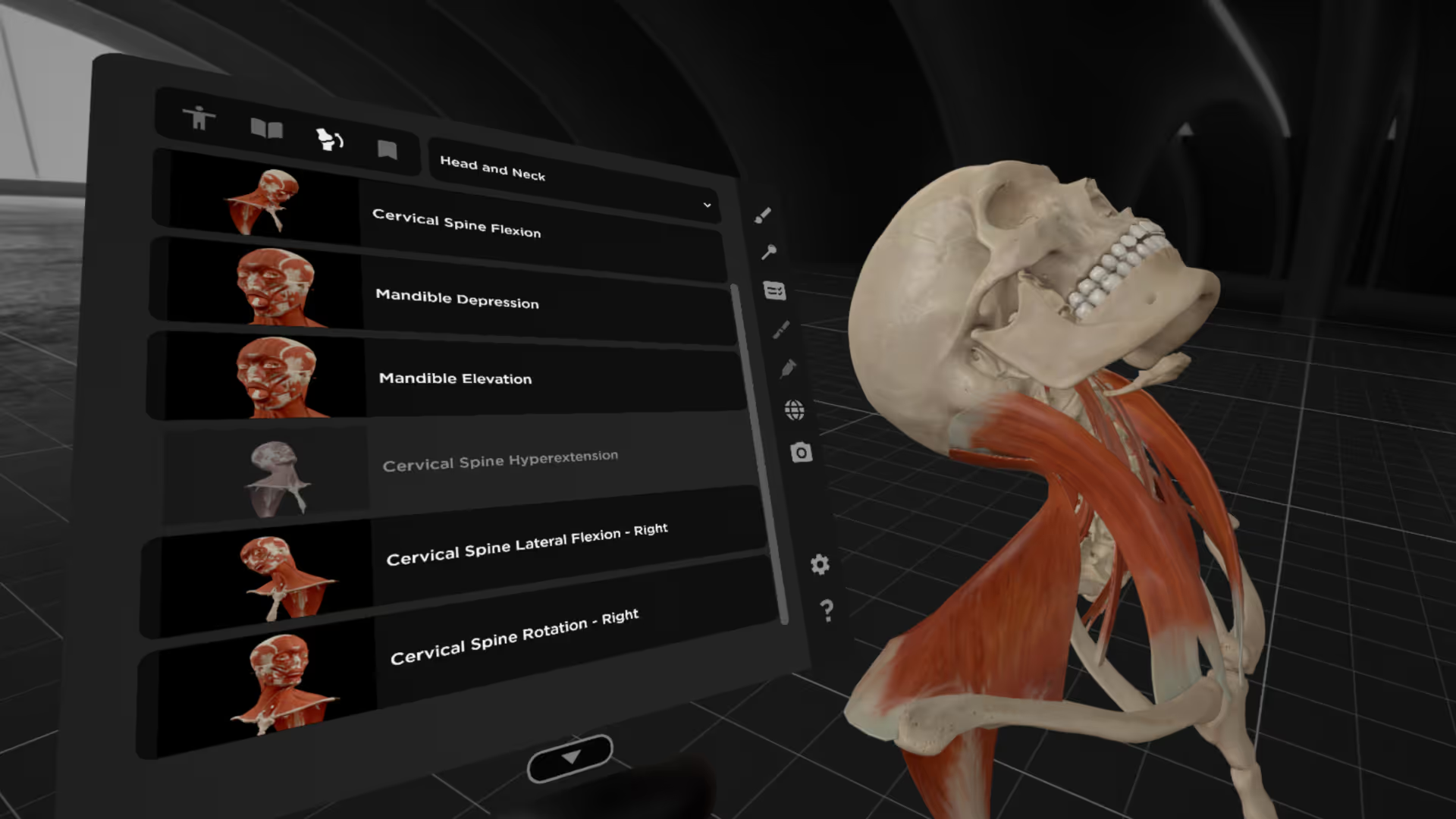

.avif)
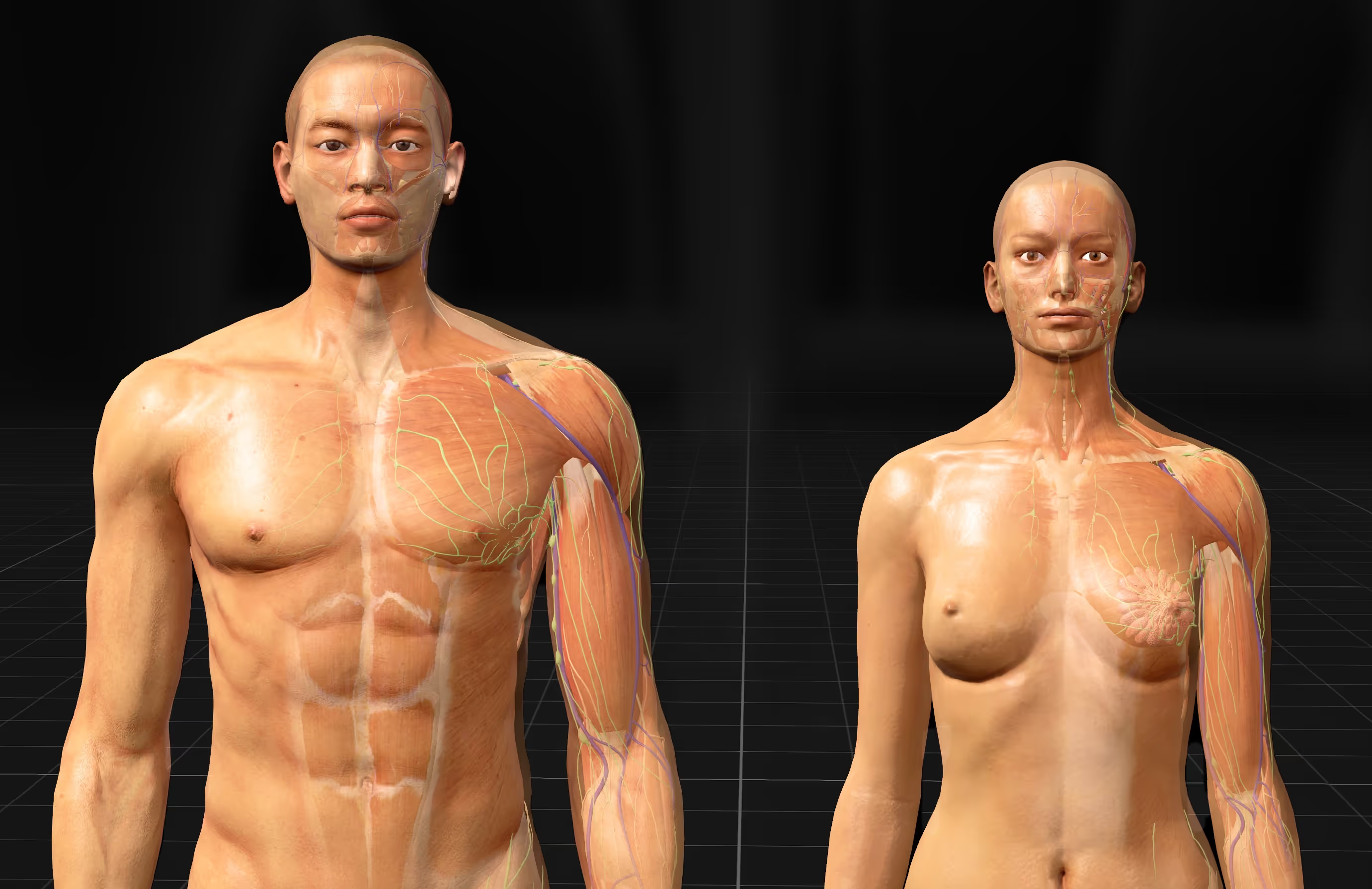

.avif)
.avif)




